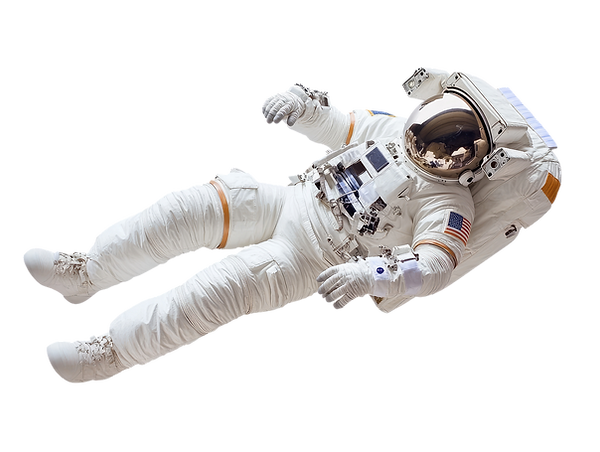



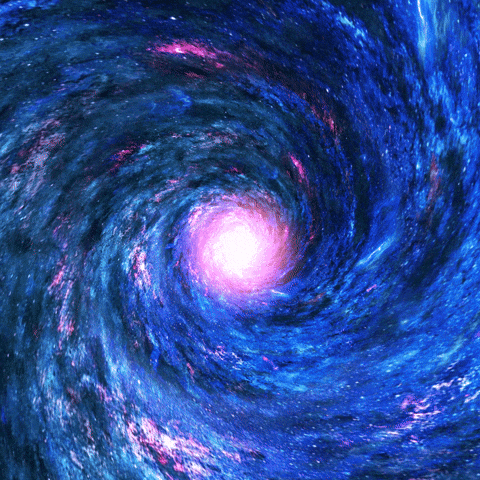
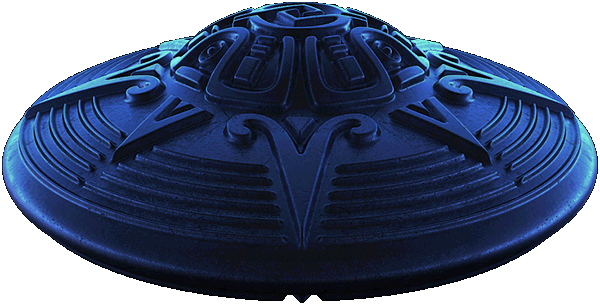


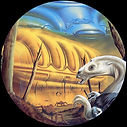

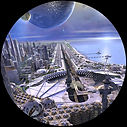

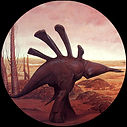



The Moon
From lighting up our skies to preserving evidence of our solar system’s history, Earth’s closest neighbor plays a pivotal role in the study of our planet and beyond.
The Moon makes Earth more livable by moderating our home planet's wobble on its axis, leading to a relatively stable climate. It also causes tides, creating a rhythm that has guided humans for thousands of years.
The Moon rotates exactly once each time it orbits our planet.
Observers on Earth can track the Moon's motion in space (relative to Earth and the Sun) through moon phases, supermoons and eclipses.
Lunar Craters
Craters are the mark the passing universe leaves on the Moon, a cosmic guestbook. On the Moon, where there’s no liquid water or wind, evidence of our solar system's impact history has been preserved for billions of years.

What Are Lunar Craters?
Lunar impact craters are the depressions left behind after an asteroid, meteoroid, or comet collides with the Moon. Though craters are visible on worlds throughout the solar system, lunar craters are special because we can see them close-up, and the relative lack of erosion and other surface processes on the Moon keep them well-preserved.
Moon craters fascinate us because they are a record of the process that built and shaped our entire solar system, the fingerprints of history pressed into the lunar surface.
The lunar north pole, captured by the Lunar Reconnaissance Orbiter Camera, is dappled with craters highlighted in a stark display of sunlight and shadow.
NASA/GSFC/Arizona State University
Why Does the Moon Have Craters?
Solar systems form through collision. Tiny flecks of dust strike and stick to one another, gradually transforming through accumulation into pebbles, boulders, and planetoids, and then finally into planets. The bits and pieces left behind by this process are still here as the rocky and icy objects that populate areas in our solar system like the asteroid belt, Kuiper Belt and Oort Cloud.
Collisions continue even today, with solar system bodies periodically pummeled by these leftovers. The meteoroids, asteroids and comets left swirling about the Sun are occasionally drawn into a gravitational embrace with their bigger siblings. On Earth, erosion and plate tectonics slowly erase their imprints. But when we look at the sky, the Moon’s craters are visual proof of the messy process that led to our planet’s creation.
Meteor Crater in Arizona is a young crater at only 50,000 years old, and is well-preserved by the arid climate of the Colorado Plateau.
USGS
A supercomputer simulation shows a Mars-sized body crashing into Earth, a potential formation scenario for our Moon early in the solar system's history.
NASA's Ames Research Center
In this striking view of the Moon's Giordano Bruno crater from the Lunar Reconnaissance Orbiter, the height and sharpness of the rim are evident. These features indicate Giordano Bruno is a young crater, though its exact age is unknown. Recent crater counts suggest it formed up to 10 million years ago.
NASA/GSFC/Arizona State University
Types of Craters
Simple Craters
...are typically what people would sketch out if asked to draw a crater. They look smooth and are shaped like bowls with round floors. Simple lunar craters tend to be on the small side, no more than around 6-9 miles (10-15 km) in diameter.
Complex Craters
...are larger than simple craters and have features like central peaks, terraces and flat floors. On the Moon, complex craters are generally around 9 miles (15 km) or more in diameter. (On Earth, they form at a much smaller size because of our planet’s stronger gravity.)
Basins
...are enormous craters that are more than 186 miles (300 km) in diameter on the Moon. Lunar samples suggest that most of the major basins on the Moon formed around 3.9 billion years ago in a still-mysterious period called the Late Heavy Bombardment. Over time, many basins filled with magma, creating the dark, basaltic Moon "mare" that we can see with the unaided eye from Earth. There are more than 40 impact basins on the Moon, and they play a significant role in the Moon’s geology. The impacts that created the Moon’s basins were intense enough to not just melt rock but also to influence volcanic flows from the Moon’s mantle.
Orientale Basin is the youngest of the large lunar basins, thought to have formed about 3.8 billion years ago. The distinct outer ring is about 590 miles (950 km) from east-to-west.
NASA/GSFC/Arizona State University
This image from Lunar Orbiter 1 shows the Korolev basin on the far side of the Moon. The basin is about 273 miles (440 km) in diameter, the largest crater in the image, to the left and slightly above the center. Adjacent to Korolev at about 5:00 is the crater Galois and at 6:30 is the smaller Doppler crater. The rim of the South Pole - Aitken basin is faintly visible running just below these craters.
NASA
How Craters Form
A lunar crater forms when an asteroid, meteoroid, or comet, typically moving faster than the speed of sound, plunges into the Moon’s surface. The energy of the object ― determined by its size, density and speed ― as well as the type of surface it hits and the angle at which it hits, all factor into what kind of crater forms in this explosive impact.
Crater formation has two phases: excavation, when the initial hole in the ground forms, and modification, when the shockwaves and their aftermath affect the entire area around the impact, causing the ground to deform and collapse. The largest craters are relatively shallow compared to their diameter due to modification, while the smaller craters keep their original deeper bowl shapes.
When an impactor contacts the Moon’s surface, it compresses, pulverizes, and vaporizes the rock beneath it. That material then rebounds, and the energy of the rock decompressing sends shockwaves racing outward through the surface, melting some of the rock if the pressure becomes high enough. Material shoots upwards and outwards. We call this spray of pulverized rock “ejecta.”
This animation shows the formation of a simple crater. Upon impact, a shock wave radiates into the crust and compresses it downward. Material in the crust flows downward, then up and out, resulting in a spray of ejecta that spreads along crater and outside it. Simple craters, unlike complex craters, stay relatively deep and have a basic bowl/cone shape. This animation is representative and does not reflect an accurate timescale. For original animations, see https://www.lpi.usra.edu/exploration/training/resources/impact_cratering/
NASA/Vi Nguyen; Original: Ross W. K. Potter/Center for Lunar Science and Exploration/Lunar and Planetary Institute
Chemicals found in the surface ice of Cabeus crater near the Moon's south pole indicate that the crater was probably created by a comet.
NASA/GSFC/Arizona State University
Lichtenberg B is a beautifully preserved simple impact crater, located northwest of Aristarchus Plateau in Oceanus Procellarum.
NASA/GSFC/Arizona State University
Starting at the rim of the crater Lichtenberg B, impact melt flowed and formed a channel, pushing boulders aside in the process.
NASA/GSFC/Arizona State University
Some of the ejecta may be large enough to cause secondary craters when it crashes back to the surface ― these smaller craters will later be seen as chains or clusters of craters pointing back to the main crater. Most of the ejecta spreads out in the area around the crater, thicker and more uniform nearest the crater. Plumes of ejecta that settle back onto the surface form the bright rays seen radiating from many of the Moon's craters. And a portion of the ejecta may even reach orbit, as evidenced by lunar meteorites found on Earth.
When the energy of the impact is powerful enough, the rebounding material stops acting like a solid and behaves like a liquid. Like the rebound from a water droplet splashing into a puddle, the liquefied rock can form a peak in the center of the crater that rises and then collapses. As the rebound forms that central peak, material from the crater rim rushes in to fill the suddenly empty space. Large blocks of rock begin to fault and slump inward, expanding the diameter of the crater and creating the stepped features called terraces. If the impactor has even more energy, clusters or even rings of peaks can form as the crater’s central material rises and then gets pulled back by gravity.
This model shows the formation of a complex crater. Initially, a bowl-shaped cavity is excavated, but as the crust rebounds a central peak forms within minutes. The walls of the crater collapse and form terraces under the influence of gravity, leaving behind a shallower and wider crater than a simple crater. This animation is representative and does not reflect an accurate timescale. For original animations, see https://www.lpi.usra.edu/exploration/training/resources/impact_cratering/
NASA/Vi Nguyen; Original: Ross W. K. Potter/Center for Lunar Science and Exploration/Lunar and Planetary Institute
The rock at the crater’s surface settles and cools into a layer of something called lunar breccia, a type of igneous rock made up of coarse, angular, shattered fragments of older rocks glued together by molten rock. Beneath that, the bedrock will have fractured, the cracks eventually tapering out as they plunge deep into the crust.
Chains and clusters of secondary craters lead back to Copernicus crater in the distance. These craters were produced by material ejected when Copernicus formed.
Lunar and Planetary Instituteu003cbru003e
A giant swirl (or whorl) of impact melt formed in a clockwise direction within one of the larger impact melt pools inside Giordano Bruno crater.
NASA/GSFC/ASU
This sawn Apollo mission sample is a lunar breccia typical of ejecta from large basins.
NASA
How Basins Form
Lunar basins are just giant craters, the aftermath of world-transforming impacts. The space rocks that created the Moon’s basins are arguably more responsible than any other factor for the appearance of the Moon we see in the sky ― and for much of its geology.
The “maria” that make up the faces and characters that people imagine in the Moon are giant pools of basalt, an igneous rock formed from the magma that welled up through cracks in the crust created after impactors carved basins into the lunar surface.
Basins are defined as being more than 186 miles (300 km) in diameter. They can be multiple times larger than the excavation of the initial crater, expanding as the territory around them is wracked and reshaped by impact-generated forces. The largest basin on the Moon, the South Pole-Aitken Basin, is thought to be four times larger than its initial excavation.
During basin formation, the initial impact and its rebound removes and melts so much material that the entire area becomes structurally unsound, causing faults to form in the surrounding land and the walls of the crater to collapse inward, drawing in material from a wider region. The initial impact crater is erased by the intensity of the aftermath.
Some basins are surrounded by multiple rings. The process of ring formation is still being studied, but scientists suspect that the rings are the result of a combination of faults and the rise and collapse of peaks that form during the impact.
When a basin forms, the initial crater is erased in the violent aftermath. The impact deforms not just the crust (light gray) but the mantle (dark gray) as well, and mantle material rises near the surface. The central peaks that form are unstable and collapse, as do the walls of the crater, while most of the material carved out by the excavation is distributed outside the crater. This animation is representative and does not reflect an accurate timescale. For original animations, see https://www.lpi.usra.edu/exploration/training/resources/impact_cratering/
NASA/Vi Nguyen; Original: Ross W. K. Potter/Center for Lunar Science and Exploration/Lunar and Planetary Institute
The Nectaris basin is 534 miles (860 km) in diameter and formed about 3.8–3.9 billion years ago.
Lunar Reconnaissance Orbiter
Schrödinger basin is a large impact feature on the far side of the Moon, near the lunar South Pole. This overhead visualization of Schrödinger basin shows the cycle of sunlight and shadow highlighting the inner peak ring and outer rim.
NASA's Scientific Visualization Studio
Another key feature of basins are the smooth floors left behind by pooled melted rock, or “impact melt.” When a typical crater forms, material that melted in the impact can be scattered and tossed out of the crater as ejecta. This impact melt can be visible at the surface, flowing down the slopes of the crater or draping features. It can also be found as tiny fragments in breccias.
When a basin forms, some melted material also scatters, but the depth of the melting is so extensive ― kilometers to tens of kilometers deep ― that a substantial amount remains in the basin. In the case of the giant South Pole-Aitken Basin, the solidified impact melt sheet is thought to be 31 miles (50 km) thick.
It can take millions of years for such deep pools of melted rock to cool, and during that time any new impactors will strike a thin crust over a thick layer of molten rock, leaving no craters behind and making the area appear young to observers. As these melt sheets cool and crystalize they contract, creating depressions in the centers of the basins. These depressions can remain visible even after they are covered by basalt deposits from later volcanic flows.


Water & Ices on the Moon
What’s big, covered in water, yet 100 times drier than the Sahara Desert? It’s not a riddle, it’s the Moon! For centuries, astronomers debated whether water exists on Earth’s closest neighbor. In 2020, data from NASA’s SOFIA mission confirmed water exists in the sunlit area of the lunar surface as molecules of H2O embedded within, or perhaps sticking to the surface of, grains of lunar dust. Here is a brief history of the discoveries leading up to the confirmation of water on the Moon.
Maria on the Moon (1645)
When early astronomers looked up at the Moon, they were struck by the large, dark spots on its surface. In 1645, Dutch astronomer Michael van Langren published the first-known map of the Moon referring to the dark spots as “maria” – the Latin word for “seas” – and putting into writing the widely-held view that the marks were oceans on the lunar surface. Similar maps from Johannes Hevelius (1647), Giovanni Riccioli and Francesco Grimaldi (1651) were published over the next few years. We now know these spots to be plains of basalt created by early volcanic eruptions, but the nomenclature of ‘maria’ (plural) or ‘mare’ (singular) remains.
A map of the Moon, featuring the maria depicted as oceans, published by astronomer Michael Van Langren in 1645.
Creative Commons
Totally Dry Moon (1892)
American astronomer William Pickering made measurements in the late 1800s that led him to conclude the Moon essentially has no atmosphere. With no clouds and no atmosphere, scientists generally agreed that any water on the lunar surface would evaporate immediately. Pickering’s measurements led to a widespread view that the Moon was devoid of water.
An open page of astronomer William Pickering’s book “The Moon: A Summary of Our Satellite with a Complete Photographic Atlas.” Pickering’s observations of the Moon lead to the belief that with such little atmospheric pressure, any ice on the lunar surface would near instantly sublimate.
Internet Archive/Knopf Doubleday (This image is in the public domain)
Ideas of Water (1960s)
As scientists made headway in understanding the behavior of substances that are prone to vaporize at relatively low temperatures – called volatiles – theoretical physicist Kenneth Watson published a paper in 1961 describing how a substance like water could exist on the Moon. Watson’s paper first popularized the idea that water ice could stick to the bottom of craters on the Moon that never receive light from the Sun, while sunlit areas on the Moon would be so hot that water would evaporate near-instantly. These lightless areas of the Moon are called “permanently shadowed regions.”
The Shackleton Crater at the Moon’s south pole in a permanently shadowed region of the Moon.
NASA
Apollo Landings (1969 – 1972)
The Apollo era brought humans to the lunar surface for the very first time, giving researchers the opportunity to directly look for signs of water on the Moon. When tested, soil samples brought back by Apollo astronauts revealed no sign of water. Scientists concluded that the lunar surface must be completely dry, and the prospect of water wasn’t seriously considered again for decades.
Apollo 17 astronaut Eugene Cernan drives the Lunar Roving Vehicle.
NASA
Apollo 15 astronaut Jim Irwin uses a scoop to collect soil samples on the lunar surface.
NASA
Possible Frozen Water in Shadowed Craters (1994, 1998)
NASA’s Clementine mission launched in 1994 to orbit the Moon for two months and collect information about its minerals. Clementine data suggested there was ice in a permanently shadowed region of the Moon. The Lunar Prospector Mission focused on permanently shadowed craters to look deeper into the discovery and in 1998 found that the largest concentrations of hydrogen exist in the areas of the lunar surface that are never exposed to sunlight. The results indicated water ice at the lunar poles. However, the images were low resolution so no strong conclusions could be made.
A mosaic image of the south pole of the Moon as taken by NASA’s Clementine spacecraft.
NASA/JPL/USGS
Revisiting Apollo Samples (2008)
Capitalizing on major advances in technology since the Apollo era, researchers from Brown University revisited the Apollo samples. They found hydrogen inside tiny beads of volcanic glass. Since no volcanoes are erupting on the Moon today, the discovery presented evidence that water had existed in the Moon when the volcanoes erupted in the Moon’s ancient past. Additionally, the preserved hydrogen provided clues to the origins of lunar water: if it emerged from erupting volcanoes, it must have come from within the Moon. The discovery suggested that water was a part of the Moon since its early existence – and perhaps since it first formed.
Apollo 17 astronaut Eugene Cernan preparing to collect samples.
NASA
Glass beads produced by ancient volcanic eruptions on the Moon and collected by Apollo astronauts.
NASA
Signs of Hydration (2009)
Chandrayaan, Cassini, Deep Impact
A suite of spacecraft enabled exciting discoveries in 2009. None were designed to look for water on the Moon, yet the Indian Space Research Organization’s Chandrayaan-1 and NASA’s Cassini and Deep Impact missions detected signs of hydrated minerals in the form of oxygen and hydrogen molecules in sunlit areas of the Moon. Researchers couldn’t determine whether they were seeing hydration by hydroxyl (OH) or water (H2O). They also debated whether the amount of hydration depended on the time of day.
Artist’s depiction of NASA’s Cassini spacecraft.
NASA/JPL-Caltech
Observations of Lunar Debris Reveal More (2009 – 2019)
The Lunar Crater Observation and Sensing Satellite (LCROSS) spacecraft and Lunar Reconnaissance Orbiter (LRO) launched together in 2009. Later that year, LCROSS intentionally discharged a projectile into a crater believed to contain water ice, and flew through the debris from the projectile’s impact. Four minutes later, LCROSS itself intentionally impacted the Moon while LRO observed. The combined observations showed grains of water ice in the ejected material. The LRO and LCROSS findings added to a growing body of evidence that water exists on the Moon in the form of ice within permanently shadowed regions. LRO continues to orbit the Moon and provide data used to characterize and map lunar resources, including hydrogen.
Artist rendering of the LCROSS satellite.
NASA/JPL
Areas of the Moon’s south pole with possible deposits of water ice, shown in blue. The map is based on data taken by NASA’s Lunar Reconnaissance Orbiter.
NASA
Confirmation of Moon Water – Shadowed Regions (2018)
Data from Moon Mineralogy Mapper (M3), carried by ISRO's Chandrayaan-1, provided scientists with the first high-resolution map of the minerals that make up the lunar surface. The NASA instrument flew aboard India’s Chandrayaan-1 mission in 2009. An analysis of the full set of data from M3, announced in 2018, revealed multiple confirmed locations of water ice in permanently shadowed regions of the Moon.
A composite image using data from NASA’s Moon Mineralogy Mapper. The blue shows areas of confirmed water ice on the lunar surface.
ISRO/NASA/JPL-Caltech/Brown University/USGS
Confirmation of Moon Water – Sunlit Surface (2020)
In 2020, NASA announced the discovery of water on the sunlit surface of the Moon. Data from the Stratospheric Observatory for Infrared Astronomy (SOFIA), revealed that in Clavius crater, water exists in concentrations roughly equivalent to a 12-ounce bottle of water within a cubic meter of soil across the lunar surface. The discovery showed that water could be distributed across the lunar surface, even on sunlit portions, and not confined to cold, dark areas.
An illustration of H2O molecules on the lunar surface. NASA’s SOFIA confirmed the existence of water on the sunlit surface of the Moon in 2020.
NASA
First Detailed, Wide-Area Map of Water on the Moon (2023)
In 2023, a new map of water distribution on the Moon provided hints about how water may be moving across the Moon’s surface. The map, made using SOFIA data, extends to the Moon’s South Pole – the intended region of study for NASA’s Artemis missions, and the water-hunting rover, VIPER.
More to Discover
Researchers have confirmed that water exists both in the sunlit and shadowed surfaces of the Moon, yet many questions remain. Lunar scientists continue to investigate the origins of water and its behavior. There is evidence that the water on the Moon comes from ancient and current comet impacts, icy micrometeorites colliding on the lunar surface, and lunar dust interactions with the solar wind. However, more research is needed to understand the full history, present, and future of water on the Moon.
I'm a paragraph. Click here to add your own text and edit me. It's easy.


Moon in Motion: Phases, Patterns, and More
Does the Moon rotate? Does the Moon spin on its axis?
Yes! The time it takes for the Moon to rotate once on its axis is equal to the time it takes for the Moon to orbit once around Earth. Thanks to this synchronous rotation, the same side of the Moon always faces our planet.
If the Moon did not rotate on its axis at all, or if it rotated at any other rate, then we would see different parts of the Moon throughout the month.
Does the Moon orbit Earth?
Yes. The Moon takes about one month to orbit Earth (27.3 days to complete a revolution, but 29.5 days to change from new moon to new moon). As the Moon completes each 27.3-day orbit around Earth, both Earth and the Moon are moving around the Sun. Because of this change in position, sunlight appears to hit the Moon at a slightly different angle on day 27 than it does on day zero ― even though the Moon itself has already traveled all the way around Earth. It takes a little more than two additional days for sunlight to hit the Moon in the same way it did on day zero. This is why it takes 29.5 days to get from new moon to new moon, even though it doesn’t take quite that long for the Moon itself to travel once around Earth.
Are Moon phases the same everywhere on Earth?
Yes, everyone sees the same phases of the Moon. People north and south of the equator do see the Moon’s current phase from different angles, though. If you traveled to the other hemisphere, the Moon would be in the same phase as it is at home, but it would appear upside down compared to what you're used to! For example, on March 8, 2021, the Moon was in a waning crescent phase.
Seen from the Northern Hemisphere, the waning crescent appeared on the left side of the Moon. Seen from the Southern Hemisphere, the crescent appeared on the right.
Are Moon phases caused by shadows from Earth?
No. The only time Earth’s shadow affects our view of the Moon is during a lunar eclipse. Generally, one half of the Moon ― the side facing the Sun ― is brightly illuminated, and one is in shadow. We use moon phases to describe the way our perspective on the half-lit Moon changes as Earth and Moon move through space over the course of a month. During a crescent moon, for example, the part of the Moon that faces Earth is mostly in shadow, and the far side of the Moon is mostly sunlit. The visible crescent is the only part of the lunar nearside that is experiencing daytime.
Data visualization of a waning crescent moon as seen from the northern hemisphere. During this phase, it is night on most of the near side of the Moon, and day on most of the far side of the Moon.
NASA’s Science Visualization Studio
Why do we see Moon phases?
The Moon is always half-lit by the sun (except during a lunar eclipse). The side of the Moon facing the Sun appears bright because of reflected sunlight, and the side of the Moon facing away from the Sun is dark. Our perspective on the half-lit Moon changes as the Moon orbits Earth. When the side nearest to us is fully lit, we call this a full Moon. When the far side is fully lit and the near side is dark, we call this a new Moon. When we see other phases, we are looking at the division between lunar night (the dark part) and day (the bright part).
Is there a "dark side of the Moon"?
There is no permanent dark side of the Moon. The far side of the Moon gets as much sunlight as the near side. Like Earth, the Moon has a day side and a night side, which change as the Moon rotates.
The Sun always illuminates half of the Moon while the other half remains dark, but how much we are able to see of that illuminated half changes as the Moon travels through its orbit. When it's daytime on the near side of the Moon, that's the full moon phase. When it's nighttime on the near side of the Moon, that's the new moon phase.
What is the Moon really shaped like?
The Moon is shaped like an imperfect sphere. From a distance, it looks nearly round. Seen up close, the Moon’s surface is a three-dimensional landscape of mountains, valleys, and craters. Explore the Moon’s surface from wherever you are in this 3D map built from data captured by NASA’s Lunar Reconnaissance Orbiter (LRO). From Earth, our view of the Moon's sunlit surface changes throughout the month. Learn about crescent moons, full moons, and other moon phases here.
Can I see the Moon during the day?
Yes! The Moon is up just as much during the day as it is at night, but you might not notice it as easily. Because the Sun is also up, and because the Moon phases that are most often visible in daylight show us only a little bit of the Moon’s bright side (like the crescent Moon phases), the Moon is harder to see during the day.
Why does the Moon rise and set? Can people in different countries see the Moon on the same day?
Moonrises and moonsets occur for the same reason as sunrises and sunsets: Earth rotates once a day. This means that observers in many different parts of the world have their turn looking at the Moon throughout each day, just like we all see the same Sun over the course of 24 hours.
Moonrise and moonset times change each day as the Moon moves through its monthly orbit around Earth. Learn more about the Moon's motion through space here.
Why does the Moon look largest close to the horizon?
This is an optical illusion. Prove it for yourself here!
Origin and Nature of the Moon
Does the Moon make its own light (like the Sun does)?
The Moon does not make its own light. “Moonlight” is really sunlight that has reflected off of the Moon’s surface.
What is moonlight? How is the Moon lit?
The Moon does not make its own light. All moonlight is reflected sunlight. The bright part of the Moon is experiencing daytime.
What is the Moon? Is it a planet?
The Moon is a natural satellite, or a space object that orbits around something else. Our Moon is Earth’s natural satellite. In general, a moon is a natural satellite of a planet, and a planet is a special kind of natural satellite that orbits a star and also meets other conditions. Learn more: What makes a planet a planet?
How did the Moon form?
The leading theory is that a Mars-sized object collided with Earth billions of years ago, and debris from this collision eventually formed the Moon. Here is an animation that shows what this might have looked like:
Animation showing the Moon's early history. Credit: NASA's Scientific Visualization Studio
Does the Moon have gravity? Do things float “up” when dropped on the Moon?
The Moon does have gravity. Because the Moon has less mass than Earth, its gravitational pull is weaker (about one-sixth of Earth’s). On the Moon, you’d be able to jump about six times as high as you can on Earth ― but you would still come back down!
What would happen if there was no Moon? How does the Moon affect Earth?
Earth would be a very different world if it had no Moon. The Moon's gravity keeps our planet from wobbling on its axis too much, which helps to stabilize our climate. The Moon also plays an important role in creating Earth's ocean tides.


Weather on the Moon
On the Moon, snow does not fall. Thunder never rolls. No clouds form in the pitch-black sky. “Weather” on the Moon means something completely different than it does on Earth. The lunar climate is dominated by temperature swings of hundreds of degrees, incoming space rocks of all sizes, and particles and energy traveling from the Sun and beyond.
Extreme Exosphere
Searing heat and bone-chilling cold are both common on the Moon, and changes in temperature are quick and dramatic, because the Moon doesn’t have an atmosphere like Earth does. One cubic centimeter of Earth’s atmosphere contains one hundred trillion times as many molecules as the same amount of space near the lunar surface. In other words, the lunar environment is almost empty, but not quite. The barely-there layer of gas around the Moon is called an exosphere.
Visualization of data from NASA's Lunar Reconnaissance Orbiter showing a permanently shadowed lunar crater.
NASA's Scientific Visualization Studio
The lunar exosphere is too skimpy to trap or spread the Sun’s energy, so differences between sunlit and shadowed areas on the Moon are extreme. Temperatures near the Moon’s equator can spike to 250°F (121°C) in daylight, then plummet after nightfall to -208°F (-133°C). In deep craters near the Moon’s poles, permanent shadows keep the surface even colder — NASA’s Lunar Reconnaissance Orbiter has measured temperatures lower than -410°F (-246°C). These forever-dark places harbor ice deposits that may be billions of years old.
Weather from Space
The Moon’s exosphere is much too thin to produce weather as we know it on Earth. Instead, lunar “weather” comes straight from space.
It's Just a Phase
In our entire solar system, the only object that shines with its own light is the Sun. That light always beams onto Earth and Moon from the direction of the Sun, illuminating half of our planet in its orbit and reflecting off the surface of the Moon to create moonlight. Sometimes the entire face of the Moon glows brightly. Other times we see only a thin crescent of light. Sometimes the Moon seems to disappear. These shifts are called moon phases.
The eight lunar phases are, in order: new moon, waxing crescent, first quarter, waxing gibbous, full moon, waning gibbous, third quarter, and waning crescent. The cycle repeats once a month (every 29.5 days).
This graphic shows the position of the Moon and the Sun during each of the Moon’s phases and the Moon as it appears from Earth during each phase. Not to scale.
NASA/JPL-Caltech
Like Earth, the Moon has a day side and a night side, which change as the Moon rotates. The Sun always illuminates half of the Moon while the other half remains dark, but how much we are able to see of that illuminated half changes as the Moon travels through its orbit.
Let’s take a look at the individual phases, and how the movements of the Moon and Sun appear to us as we watch from the Northern Hemisphere on Earth:
New Moon
This is the invisible phase of the Moon, with the illuminated side of the Moon facing the Sun and the night side facing Earth. In this phase, the Moon is in the same part of the sky as the Sun and rises and sets with the Sun. Not only is the illuminated side facing away from the Earth, it’s also up during the day! Remember, in this phase, the Moon doesn’t usually pass directly between Earth and the Sun, due to the inclination of the Moon’s orbit. It only passes near the Sun from our perspective on Earth.
Waxing Crescent
This silver sliver of a Moon occurs when the illuminated half of the Moon faces mostly away from Earth, with only a tiny portion visible to us from our planet. It grows daily as the Moon’s orbit carries the Moon’s dayside farther into view. Every day, the Moon rises a little bit later.
First Quarter
The Moon is now a quarter of the way through its monthly journey and you see half of its illuminated side. People may casually call this a half moon, but remember, that’s not really what you’re witnessing in the sky. You’re seeing just a slice of the entire Moon ― half of the illuminated half. A first quarter moon rises around noon and sets around midnight. It’s high in the sky in the evening and makes for excellent viewing.
Waxing Gibbous
Now most of the Moon’s dayside has come into view, and the Moon appears brighter in the sky.
Full Moon
This is as close as we come to seeing the Sun’s illumination of the entire day side of the Moon (so, technically, this would be the real half moon). The Moon is opposite the Sun, as viewed from Earth, revealing the Moon’s dayside. A full moon rises around sunset and sets around sunrise. The Moon will appear full for a couple of days before it moves into…
Waning Gibbous
As the Moon begins its journey back toward the Sun, the opposite side of the Moon now reflects the Moon’s light. The lighted side appears to shrink, but the Moon’s orbit is simply carrying it out of view from our perspective. The Moon rises later and later each night.
Last Quarter
The Moon looks like it’s half illuminated from the perspective of Earth, but really you’re seeing half of the half of the Moon that’s illuminated by the Sun ― or a quarter. A last quarter moon, also known as a third quarter moon, rises around midnight and sets around noon.
Waning Crescent
The Moon is nearly back to the point in its orbit where its dayside directly faces the Sun, and all that we see from our perspective is a thin curve.


Anywhere from four to seven times a year, our Earth, Moon and Sun line up just right to create the cosmic-scale shadow show known as an eclipse. The Moon's orbit around Earth is tilted relative to Earth's orbit around the Sun. This tilt is the reason why we have occasional eclipses instead of eclipses every month.
There are two types of eclipses: lunar and solar. During a lunar eclipse, Earth’s shadow obscures the Moon. During a solar eclipse, the Moon blocks the Sun from view.
Observers in the Western Hemisphere will have the opportunity to view a total lunar eclipse in March 2025. Here’s what you need to know.
NASA/Vi Nguyen
Lunar Eclipse Basics
Lunar eclipses occur at the full moon phase. When Earth is positioned precisely between the Moon and Sun, Earth’s shadow falls upon the surface of the Moon, dimming it and sometimes turning the lunar surface a striking red over the course of a few hours. Each lunar eclipse is visible from half of Earth.
Types of Lunar Eclipses
Total lunar eclipse
The Moon moves into the inner part of Earth’s shadow, or the umbra. Some of the sunlight passing through Earth’s atmosphere reaches the Moon’s surface, lighting it dimly. Colors with shorter wavelengths ― the blues and violets ― scatter more easily than colors with longer wavelengths, like red and orange. Because these longer wavelengths make it through Earth’s atmosphere, and the shorter wavelengths have scattered away, the Moon appears orangish or reddish during a lunar eclipse. The more dust or clouds in Earth’s atmosphere during the eclipse, the redder the Moon appears.
Partial lunar eclipse
An imperfect alignment of Sun, Earth and Moon results in the Moon passing through only part of Earth's umbra. The shadow grows and then recedes without ever entirely covering the Moon.
Penumbral eclipse
If you don’t know this one is happening, you might miss it. The Moon travels through Earth’s penumbra, or the faint outer part of its shadow. The Moon dims so slightly that it can be difficult to notice.
Upcoming Lunar Eclipses
DateEclipse TypeGeographic Region of Visibility
March 14, 2025 (UTC)TotalPacific, Americas, Western Europe, Western Africa
September 7, 2025 (UTC)TotalEurope, Africa, Asia, Australia
March 3, 2026 (UTC)TotalEast Asia, Australia, Pacific, Americas
August 28, 2026 (UTC)PartialEast Pacific, Americas, Europe, Africa
The Moon and Solar Eclipses
Solar eclipses happen only at the new moon phase, when the Moon is between Earth and the Sun. During a solar eclipse, the Moon casts a shadow on Earth, and blocks or partially blocks our view of the Sun. Though solar eclipses happen as often as lunar eclipses, they are visible from such a small area of Earth each time that it’s much rarer to encounter one.
n this animation, the umbra portion of the Moon’s shadow barely reaches the Earth as it traces a path across North America. Credit: NASA's Scientific Visualization Studio.
During a solar eclipse, the Moon's shadow on Earth’s surface is only about 300 miles (480 km) wide. The shadow consists of two parts, the umbra, where the Sun is completely blocked, and the penumbra, where the Sun is partially obscured. People in the umbra will see a total eclipse, while people in the penumbra will see a partial eclipse. Though the shadow is narrow and the total eclipse lasts for only minutes, our planet rotates fast enough to bring the shadow a third of the way around Earth's surface before the Moon moves out of alignment with the Sun.
Upcoming Solar Eclipses
DateEclipse TypeGeographic Region of Visibility
March 29, 2025PartialEurope, Asia, Africa, North America, South America, Atlantic Ocean, Arctic Ocean
September 21, 2025PartialAustralia, Antarctica, Pacific Ocean, Atlantic Ocean
February 17, 2026AnnularAntarctica (with a partial eclipse in Antarctica, Africa, South America, Pacific Ocean, Atlantic Ocean, and Indian Ocean)
August 12, 2026TotalGreenland, Iceland, Spain, Russia, and a small area of Portugal (with a partial eclipse in Europe, Africa, North America, the Atlantic Ocean, Arctic Ocean, and Pacific Ocean)
That we often get such impressive solar eclipses on Earth is a lucky chance of nature. The Sun is vastly larger than the Moon ― its diameter is about 400 times the Moon’s. But the Moon is roughly 400 times closer to Earth. This makes it possible for the Moon to almost perfectly block out the Sun when everything aligns.
This state of affairs won’t last forever. The Moon started its existence much closer to Earth, and has been slowly drifting outward at the rate of about 1.5 inches (3.8 cm) per year. Once it makes it past 14,600 miles (23,500 km), it’ll appear too small from Earth to cover the Sun. But don’t panic if you haven’t seen an eclipse yet ― you’ve got another 600-million-plus years before that border is breached. In the meantime, you can get a preview during an annular eclipse, when the Sun, Moon and Earth align but the Moon’s orbit places it too far away from Earth to entirely block the disk of the Sun. During an annular eclipse, the sky takes on a twilight cast, but some of the Sun still shows.
The Moon's Tilted Orbit
The Moon’s orbit is tilted about 5 degrees compared to the plane of Earth’s orbit around the Sun. Because of this tilt, the Moon as seen from Earth’s perspective usually passes above or below the Sun when it passes between us and the Sun. The tilt of the Moon’s orbit prevents us from having monthly solar and lunar eclipses.

